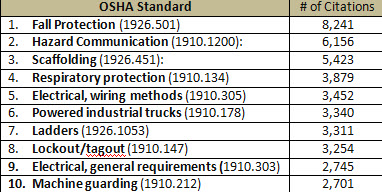OSHA's Top 10 List
OSHA’s latest top 10 list of violations was announced at the National Safety Council’s 2013 Congress and Expo in Chicago. OSHA’s fiscal year is from Oct. 1, 2012 to Sept. 30, 2013.
The following table details the top 10 standards violated, along with the preliminary number of citations:

Fall Protection, Scaffolding and Ladder violations are from the construction industry while the remainder are related to the general industry standards.
The top violations continue to be the same year after year with only minor deviations in the order. Businesses should have employees familiar with the common standards most frequently cited under each of the above standard categories. The following lists identify the most common standards violated under each of the OSHA top 10:
1. Fall Protection (1926.501):
a) 1926.501(b)(13) 6 feet or more above lower levels shall be protected from falls.
b) 1926.501(b)(1) Employees exposed to unprotected sides and edges >6 feet.
c) 1926.501(b)(10) Employees exposed to falls while working on low-slope roofs.
d) 1926.501(b)(11) Employees exposed to falls while working on steep-slope roofs.
e) 1926.501(b)(4)(i) Employees not protected from falling through holes to lower levels.
2. Hazard Communication (1910.1200)
a) 1910.1200(e)(1) Develop, implement, and maintain a written hazard communication program.
b) (1910.1200(h)(1) Provide effective training.
c) 1910.1200(f)(5) Chemical containers not labeled to identify contents.
d) 1910.1200(g)(1) Missing SDS forms for chemicals used in the workplace.
e) 1910.1200(g)(8) SDS’s not readily accessible during each work to all employees.
3. Scaffolding (1926.451):
a) 1926.451(g)(1) Scaffold more than 10 feet above a lower level shall requires fall protection. (MEMIC expects fall protection at a minimum height of 6 feet for construction)
b) 1926.451(b)(1) Platform on all working levels fully planked between front uprights and guardrail supports.
c) 1926.451(e)(1) Two or more feet above or below point of access requires ladder, stair, ramp, or similar surface. Crossbraces shall not be used as a means of access.
d) 1926.451(c)(2) Poles, legs, posts, frames, and uprights shall bear on base plates and mud sills.
e) 1926.451(g)(4) Any guardrail systems shall comply with 1926.451 Appendix B.
4. Respiratory protection (1910.134)
a) 1910.134(c)(1) Respirators when required need written respirator program.
b) 1910.134(e)(1) Medical evaluation required before employee is fit tested and issued respirator.
c) 1910.134(c)(2) “Voluntary Respirator Use” Verify it won’t create a hazard. Requires training using 1910.134 Appendix D.
d) 1910.134(f)(2) Tight-fitting respirators require fit testing at least annually
e) 1910.134(d)(1) Employer shall select and provide an appropriate respirator.
5. Electrical, wiring methods (1910.305)
a) 1910.305(g)(1) Flexible cords and cables not used as a substitute for fixed wiring; not run through holes in walls, ceilings, or floors; run through doorways, windows, or similar openings; attached to building surfaces; concealed behind building walls, ceilings, or floors.
b) 1910.305(b)(1) Wiring not protected from abrasion. Openings in electrical effectively closed.
c) 1910.305(b)(2) All electrical boxes and fittings provided with covers. Lamps <8’ protected from accidental contact or breakage by a suitable fixture/guard.
d) 1910.305(g)(2) Flexible cords used only in continuous lengths. No repairs unless cord is 14 gage (12 gage construction). Flexible cords shall have strain relief provided.
e) 1910.305(a)(2) Flexible cords protected from accidental damage.
6. Powered industrial trucks (1910.178)
a) 1910.178(l)(1) Operator shall be competent and successfully completed training.
b) 1910.178(I)(4) Refresher training conducted every 3 years or after incident or changes
c) 1910.178(I)(6) Training certification required for operators
d) 1910.178(p)(1) Trucks with defects shall be taken out of service.
e) 1910.178(q)(7) Industrial trucks shall be examined each shift before being placed in service.
7. Ladders (1926.1053)
a) 1926.1053(b)(1) Portable ladders shall extend at least 3 feet above any landing.
b) 1926.1053(b)(4) Ladders used only for the purpose for which they were designed.
c) 1926.1053(b)(13) The top step of a stepladder shall not be used as a step.
d) 1926.1053(b)(16) Ladders with structural defects immediately tagged "Do Not Use" 1926.1053(b)(22) Do not carry any object or load that could cause loss of balance.
8. Lockout/tagout (1910.147)
a) 1910.147(c)(4)(i) Procedures developed, documented and utilized to control hazardous energy.
b) 1910.147(c)(6) Conduct a periodic inspection of the energy control procedure at least annually.
c) 1910.147(c)(7) Provide training to “authorized”, “affected” and “other” employees.
d) 1910.147(c)(1) Establish “energy control program”.
e) 1910.147(d)(1) Lockout or tagout devices properly affixed to each energy isolating device.
9. Electrical, general requirements (1910.303)
a) 1910.303(b)(2) Electrical equipment not used according to its listing and labeling.
b) 1910.303(g)(1) Sufficient working space provided about all electric equipment.
c) 1910.303(g)(2) Electrical equipment at 50 volts or more shall be guarded against contact
d) 1910.303(b)(1) Electric equipment free from recognized hazards
e) 1910.303(f)(2) Disconnecting means shall be legibly marked to indicate its purpose, unless located and arranged so the purpose is evident
10. Machine guarding (1910.212)
a) 1910.212(a)(1) One or more methods of machine guarding shall be provided to protect from hazards such as those created by point of operation, ingoing nip points, rotating parts, flying chips and sparks.
b) 1910.212(a)(3) Point of operation safeguarding.
c) 1910.212(b) Fixed location machinery shall be securely anchored to prevent moving.
d) 1910.212(a)(5) Fan blades less than 7’ require guards with openings no larger than (1/2) inch.
e) 1910.212(a)(2) Guards shall be affixed to the machine where possible and secured elsewhere. The guard shall not offer an accident hazard in itself.

